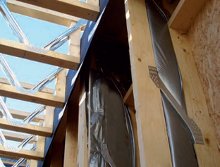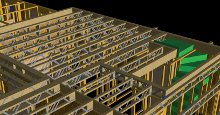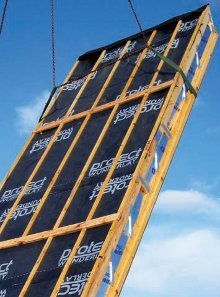Building for the future
7 July 2012Product developments at MiTek Industries are speeding up design and build processes. Robin Meade reports
With the government Business Information Modelling (BIM) waiting in the wings, and challenging economic times forcing management teams to assess their supply chains for competitive advantage, timber engineering businesses have been looking to innovate.
MiTek Industries Ltd, part of the multinational provider of engineered products and services for the building components industry, is seeking to strengthen its position with new product developments.
The company is based in Dudley where it manufactures connectors and which is the company's European base for manufacturing and software development. One of its key products, Posi-Joist, is a common choice in open-web engineered floors in the UK and one of the company's latest software developments is Posi-Framer.
MiTek says Posi-Framer is a natural progression for customers of WoodEngine timber frame detailing software that provides automatic framing of Posi-Joists from within an Autodesk environment. Posi-Framer recognises bearing details, automatically lays out decking and partition noggins, then the joists are engineered together with hangers and bracing saving hours for the floor detailer. The software can also detail and engineer Posi-Joists supported on masonry walls with the different support conditions recognised and considered in the design.
"The whole idea with Posi-Framer is that detailers don't have to keep diving between different software," said Roy Troman, sales and marketing director for MiTek in the UK and Ireland.
This is a key selling point especially since the government BIM scheme was announced last year. Under this scheme the construction industry is expected to adopt a common BIM for all public building procurement, such as schools and hospitals within four years.
The design will be a 3D model to be used throughout the entire supply chain by all the parties involved. Much of current design work is still in a 2D environment and will require a working interface between a large number of software design packages.
Mr Troman knows BIM is a complex challenge. "The government is trying to standardise the whole construction process where people are all singing from the same hymn sheet, and they want to see something easy and quick. The good news for MiTek software users is that the MiTek software is already in a great position to support construction projects using BIM," he said.
Wall framing system
Another product area waiting in the wings for MiTek is the X-Rafter roofing system, launched at Ecobuild in 2010. Mr Troman described X-Rafter as a product awaiting a market, but said it had given rise to the Posi-Stud wall framing system in which an inner and outer wall are linked with as few as three Posi-Web crosses per 2.4m stud.
The structural timber chords can be treated with preservative and sheathed. The system distributes roof and floor loads through one or both timber chords, minimises cold bridging and increases racking resistance of the wall. With mineral wool insulation it is possible to achieve U-values as low as 0.11W/m²K. Several projects have been completed with Posi-Stud and others are in progress.
Pamir is the next generation of trussed rafter software from MiTek. Named after a mountain range in the Himalayas known as the "roof of the world", it is a major development that has been several years in the making and is currently being released in Scandinavia.
"It is a brand new revolutionary software product with ease of operation and speed in creating a roof; it is much more intuitive," said Mr Troman. "It is hard to be precise as to the increase in productivity, but certainly if you take a complex roofscape, with Pamir it can be done in half the time."
The company has also developed the Revolution fully-automated high-speed Posi- Joist press, which has a patented vertical pressing station with CNC-controlled positioning of the Posi-Strut webs ensuring precise placement and eliminating lengthy setting-up procedures. It is capable of producing more than 1,500m in a shift.
"The Revolution press is a very productive innovation which can produce 2,000m a day, which keeps the cost down," said Mr Troman.
"It's important we keep our customers up to date with our developments, making sure they know we are building for the future, and their future," he added. "We supply connectors, we design the software and supply the machinery; it is they who ultimately have to manufacture the finished product."


